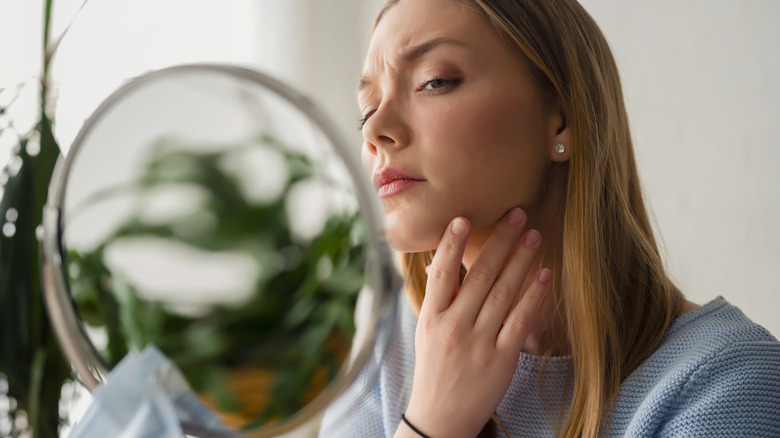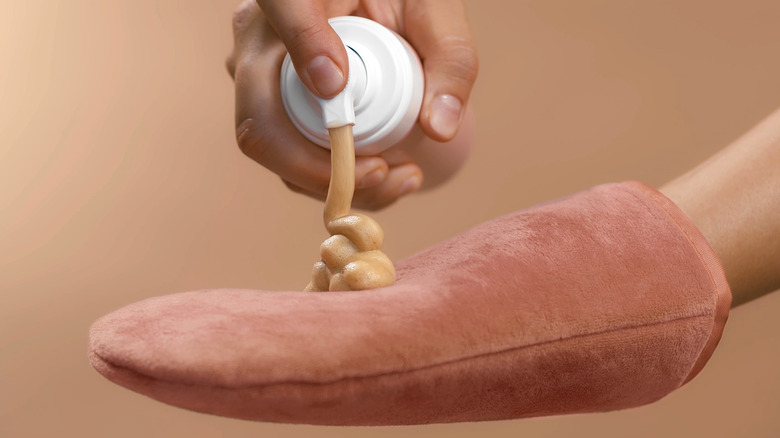How To Self-Tan Your Face Without Breaking Out
Western beauty standards demand a lot from our skin. We're supposed to have a glowing, bronzed tan, but not the premature aging and hyperpigmentation that might come from spending long hours in the sun. To get around the sun, many people use self-tanner to maintain youthful-looking skin while deepening their skin tone. However, society also expects us to have clear, acne-free skin, and that makes some people leery of using self-tanner on the face. You might even think it'd be impossible to use a self-tanner on your face without breaking out. But, it turns out, you can build a skincare routine for acne-prone skin that does include self-tanner.
Board-certified dermatologist Dr. Sam Ellis explains the basics of self-tanner and how it works in a YouTube video. Dr. Ellis says that "self-tanners contain an ingredient called dihydroxyacetone or, for short, DHA. This is a molecule that interacts with the proteins in the dead skin cell layer that sits on the surface of our skin. And when that chemical reaction happens, it causes this temporary darkening." According to Ellis, self-tanner does not permeate the skin deeply. Instead, she says it has a very surface-level effect and, as the skin eventually "sloughs off," the tan lightens.
So what does this mean for your acne? Other experts have weighed in regarding the effect self-tanners might have on your face.
How self-tanner impacts the skin on your face
Unfortunately, there are little to no clinical studies done on the correlation between acne and its aggravation by DHA, the active ingredient used in self-tanner. However, experts in self-tanning have advice and anecdotes to offer. For instance, professional spray tan artist Jessica Rae Buck started a YouTube channel to share her expertise on the practice. She informed viewers that almost 100% of the time, she will apply spray tan to her clients' faces. However, she reported, "No one has said they've broken out, and I've spray-tanned thousands and thousands of women at this point. No issues."
Dr. Ellis revealed some science that appears to support this. She said, "Self-tanners by nature are not supposed to be particularly comedogenic or pore-clogging, and a lot of times, it's not the dihydroxyacetone. It's not the active ingredient that's causing problems but some of the other filler ingredients within the self-tanner." So while DHA itself will likely not cause acne, everyone's skin is different, and you may need to try a few brands to see what works for you, according to Ellis. This means there are some things you should consider when selecting and applying self-tanner to your face.
How to ensure your self-tanner won't cause a breakout
There are some helpful self-tanning tips you can use to decrease the likelihood of a breakout. In conversation with Allure, board-certified dermatologist Dr. Hadley King said, "Some self-tanners are oily and can clog pores and contribute to a buildup of bacteria." Because of this, St. Tropez's tanning ambassador Sophie Evans told Allure that "If you have oily skin or are prone to breakouts, go for a self-tanner made specifically for the face, because it will be clinically tested not to block the pores [as long as it says noncomedogenic on the packaging]."
If you are extra concerned about your skin breaking out, it's even possible to find a self-tanner made to combat and prevent acne. Dr. King added, "Some self-tanners include ingredients like glycolic acid or lactic acid to gently exfoliate the skin and help minimize the risk of clogged pores."
The skin positivity movement is embracing wrinkles and acne, changing our lives and perceptions of skin beauty. However, wanting to avoid an inflamed reaction with the products you use is totally reasonable. If you have serious concerns about how self-tan may affect your unique skin, we recommend discussing this with a board-certified dermatologist.


